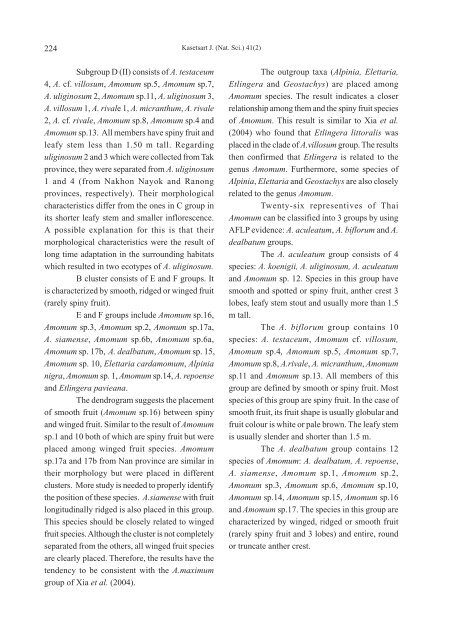April - June 2007 - Kasetsart University
April - June 2007 - Kasetsart University
April - June 2007 - Kasetsart University
Create successful ePaper yourself
Turn your PDF publications into a flip-book with our unique Google optimized e-Paper software.
224<br />
Subgroup D (II) consists of A. testaceum<br />
4, A. cf. villosum, Amomum sp.5, Amomum sp.7,<br />
A. uliginosum 2, Amomum sp.11, A. uliginosum 3,<br />
A. villosum 1, A. rivale 1, A. micranthum, A. rivale<br />
2, A. cf. rivale, Amomum sp.8, Amomum sp.4 and<br />
Amomum sp.13. All members have spiny fruit and<br />
leafy stem less than 1.50 m tall. Regarding<br />
uliginosum 2 and 3 which were collected from Tak<br />
province, they were separated from A. uliginosum<br />
1 and 4 (from Nakhon Nayok and Ranong<br />
provinces, respectively). Their morphological<br />
characteristics differ from the ones in C group in<br />
its shorter leafy stem and smaller inflorescence.<br />
A possible explanation for this is that their<br />
morphological characteristics were the result of<br />
long time adaptation in the surrounding habitats<br />
which resulted in two ecotypes of A. uliginosum.<br />
B cluster consists of E and F groups. It<br />
is characterized by smooth, ridged or winged fruit<br />
(rarely spiny fruit).<br />
E and F groups include Amomum sp.16,<br />
Amomum sp.3, Amomum sp.2, Amomum sp.17a,<br />
A. siamense, Amomum sp.6b, Amomum sp.6a,<br />
Amomum sp. 17b, A. dealbatum, Amomum sp. 15,<br />
Amomum sp. 10, Elettaria cardamomum, Alpinia<br />
nigra, Amomum sp. 1, Amomum sp.14, A. repoense<br />
and Etlingera pavieana.<br />
The dendrogram suggests the placement<br />
of smooth fruit (Amomum sp.16) between spiny<br />
and winged fruit. Similar to the result of Amomum<br />
sp.1 and 10 both of which are spiny fruit but were<br />
placed among winged fruit species. Amomum<br />
sp.17a and 17b from Nan province are similar in<br />
their morphology but were placed in different<br />
clusters. More study is needed to properly identify<br />
the position of these species. A.siamense with fruit<br />
longitudinally ridged is also placed in this group.<br />
This species should be closely related to winged<br />
fruit species. Although the cluster is not completely<br />
separated from the others, all winged fruit species<br />
are clearly placed. Therefore, the results have the<br />
tendency to be consistent with the A.maximum<br />
group of Xia et al. (2004).<br />
<strong>Kasetsart</strong> J. (Nat. Sci.) 41(2)<br />
The outgroup taxa (Alpinia, Elettaria,<br />
Etlingera and Geostachys) are placed among<br />
Amomum species. The result indicates a closer<br />
relationship among them and the spiny fruit species<br />
of Amomum. This result is similar to Xia et al.<br />
(2004) who found that Etlingera littoralis was<br />
placed in the clade of A.villosum group. The results<br />
then confirmed that Etlingera is related to the<br />
genus Amomum. Furthermore, some species of<br />
Alpinia, Elettaria and Geostachys are also closely<br />
related to the genus Amomum.<br />
Twenty-six representives of Thai<br />
Amomum can be classified into 3 groups by using<br />
AFLP evidence: A. aculeatum, A. biflorum and A.<br />
dealbatum groups.<br />
The A. aculeatum group consists of 4<br />
species: A. koenigii, A. uliginosum, A. aculeatum<br />
and Amomum sp. 12. Species in this group have<br />
smooth and spotted or spiny fruit, anther crest 3<br />
lobes, leafy stem stout and usually more than 1.5<br />
m tall.<br />
The A. biflorum group contains 10<br />
species: A. testaceum, Amomum cf. villosum,<br />
Amomum sp.4, Amomum sp.5, Amomum sp.7,<br />
Amomum sp.8, A.rivale, A. micranthum, Amomum<br />
sp.11 and Amomum sp.13. All members of this<br />
group are defined by smooth or spiny fruit. Most<br />
species of this group are spiny fruit. In the case of<br />
smooth fruit, its fruit shape is usually globular and<br />
fruit colour is white or pale brown. The leafy stem<br />
is usually slender and shorter than 1.5 m.<br />
The A. dealbatum group contains 12<br />
species of Amomum: A. dealbatum, A. repoense,<br />
A. siamense, Amomum sp.1, Amomum sp.2,<br />
Amomum sp.3, Amomum sp.6, Amomum sp.10,<br />
Amomum sp.14, Amomum sp.15, Amomum sp.16<br />
and Amomum sp.17. The species in this group are<br />
characterized by winged, ridged or smooth fruit<br />
(rarely spiny fruit and 3 lobes) and entire, round<br />
or truncate anther crest.
















